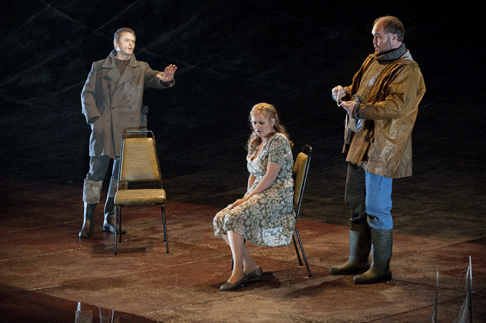When this production of Wagner’s Der fliegende Holl‰nder
premiered at the Royal Opera House in February 2009, (review
here), Bryn Terfel was its raison d’Ítre. His absence was sorely felt,
even by those who aren’t usually seduced by his charms. In this revival, the
draw was Jeffrey Tate’s return to Covent Garden after nearly 20 years.
Minimal stagings can work when they highlight meaning and music. Tim
Albery’s production (designed by Michael Levine) is a blank canvas, which
styles The Flying Dutchman rather than suggests much about who he is.
No portrait of any kind in sight. Instead, a toy boat. The boat itself is
wonderfully staged, and it’s a masterstroke to see real water on stage, lit
so its reflection shines magically into the auditorium. But it doesn’t convey
the wildness of the open ocean, nor the turbulent psychic storm around which
this opera predicates.
Perhaps Albery’s interpretation is that the opera predicates on Senta and
her frustratons, the Dutchman being a projection of her fantasies. Anja
Kempe’s Senta was extremely impressive in 2009. Then, she was a perfect foil
to Terfel’s solid, taciturn Dutchman. Kempe’s energy created Senta as
driven to extremes to escape what to her might have seemed mind numbing
conformity. The Dutchman is her ticket out of town, rather than a cursed soul.
It’s a valid interpretation, given Albery’s factory staging of the spinning
scene, and marginal references to the haunted ship. The concept is worth
exploring, though here it’s rather too simplistic. Senta’s not Tosca.
Wildness is tricky to sing into this part, and occasionally Kempe relied more
on forcefulness than finesse. Nonetheless, she can do it well, and should
settle further into the run.
Egils Silins was a late replacement for Falk Struckmann as The Dutchman.
This was his Covent Garden debut, and possibly his highest profile performance
to date. Although his voice isn’t particularly distinctive, he’s secure
vocally and does seem to have a feel for the part. In a production where the
singer has more to work with and is less exposed, he’d make a bigger impact.
Part of this stems from Albery’s approach, where the Dutchman is reduced to
little more than Senta’s dreams. It takes an unusually powerful and
charismatic singer to counterbalance these limitations.
Stephen Milling’s Daland was forcefully secure, even too noble, given that
the character has an unpleasant streak of venality, which would work well in
Albery’s concept, but wasn’t developed. Still, it’s enough that he sang
well. Endrik Wottrich’s Erik had problems with pitch and intonation, but was
reasonably well acted. Clare Shearer’s Mary was excellent — no fault of
hers that the role here was a cipher.
The role of Steersman is much bigger, and critical to the plot, for the
Steersman is guides the ship into the distance. Both Senta and the Steersman
dream, but Senta can’t think past the present. John Tessier has to sing
suspended up a rope ladder, but hasn’t quite the character to make the part
as compelling as it might be. But then many productions don’t make enough of
the role, and this production doesn’t, either. It’s odd, given Albery’s
interest in images of conformity as the Steersman is part of the crew. As
always, the Royal Opera House choruses sing and move perfectly. The vocal
battle between the Dutchman’s crew and Daland’s crew isn’t quite as
horrific as it might be, but the “Steuermann, lafl die Wacht!” refrain was
sung with such jaunty zest that it left no doubt that these sailors and their
families had no time for spooks and neurosis.
 Egils Silins as Der Holl‰nder, Anja Kampe as Senta and Stephen Milling as Daland
Egils Silins as Der Holl‰nder, Anja Kampe as Senta and Stephen Milling as Daland
And so to Jeffrey Tate’s long awaited return to London. Fortunately Albery
did not stage the protracted Overture, so we could concentrate on the
orchestra. Tate’s pace was electric, injecting the malevolent atmosphere the
staging tried so hard to suppress. The energy dissipated at other points, which
was a kindness to the singers, who didn’t have to compete, and to Albery’s
staging, which was so much at odds with the demonic, elemental fury in the
music. When the Dutchman’s crew descend back into the bowels of their ship,
Tate lets the orchestra burst forth again. They’re back on the ocean again,
metaphorically defying storms and tribulations.
For more details, please see the Royal Opera
House website.
Anne Ozorio
image=http://www.operatoday.com/Dutchman_ROH_03.gif
image_description=Egils Silins as Der Holl‰nder and Anja Kampe as Senta [Photo by Mike Hoban courtesy of The Royal Opera House]
product=yes
product_title=Richard Wagner: Der fliegende Holl‰nder
product_by=Daland: Stephen Milling; Steersman: John Tessier; The Dutchman: Egils Silins; Senat: Anja Kempe; Mary: Claire Shearer; Erik: Endrik Wottrich Orchestra and Chorus of the Royal Opera House. Chorus Director: Renato Balsadonna. Conductor: effrey Tate. Director: Tim Albery. Set designs: Michael Levine. Costumes: Constance Hoffman. Lighting: David Finn. Movement: Philippe Giradeau. Royal Opera House, London, 18th October 2011.
product_id=Above: Egils Silins as Der Holl‰nder and Anja Kampe as Senta
Photos by Mike Hoban courtesy of The Royal Opera House